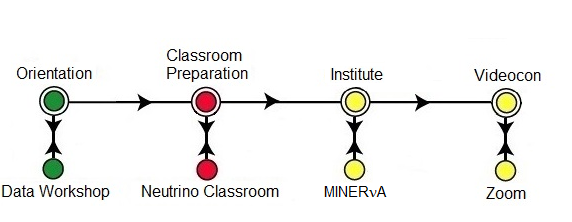Neutrino Masterclass 2023 Archive
Videoconferences
This page is to help to guide mentors and teachers in planning the masterclass videoconference.
Short URL for this page: http://tiny.cc/fnalvc.
Navigation
CERN, GSI, and KEK videoconferences
Registration
Registration polls are closed. To register or obtain further information, please email the videoconference coordinator:
- CERN - Uta Bilow
- GSI - Yiota Foka
- KEK - Rok Pestotnik
Fermilab videoconferences
Registration
Registration polls are closed. To register or obtain further information, please email the videoconference coordinator:
- Fermilab/LHC - Kenneth Cecire
- Fermilab/Neutrino - Shane Wood or Spencer Pasero
Connections
Fermilab institutes connect to videoconferences through Zoom. Channels are indicated in the schedule.
2023 Schedule for ATLAS masterclass videoconferences moderated by Fermilab
This will be updated as registrations are received.
Times(TBA) are in U.S. Central Time. (Convert to your time zone.) This schedule is subject to change.
| Date/time (U.S. Central Time) | Institutes | Moderator(s) | Staff | Zoom link |
|---|---|---|---|---|
| Sat 25 Feb/10:00 | LisboaUni | Conde, Van de Wall | Cecire, Wood | FNAL-IMC-A |
| Fri 03 Mar/15:00 | Stillwater A, Ruston | Assamagan, Bhopatkar | Trapp, Cecire | FNAL-IMC-A |
| Sat 04 Mar/15:00 | Santa Cruz | Assamagan | Wetzler | FNAL-IMC-A |
| Thu 09 Mar/15:00 | Dallas | Foti, Uribe | Cecire, Wadness | FNAL-IMC-B |
| Tue 14 Mar/13:45 | DeKalb | Glover | Wadness | FNAL-IMC-A |
| Sat 25 Mar/10:00 | Coimbra, Evora, LisboaLIP | Peixoto, Van de Wall | Wetzler | FNAL-IMC-A |
| Sat 25 Mar/15:00 | Stillwater C w/Houston | Glover. Natale | Wetzler, Trapp | FNAL-IMC-B |
| Fri 31 Mar/15:00 | Stillwater D | Hall | Cecire | FNAL-IMC-A |
2023 Schedule for CMS masterclass videoconferences moderated by Fermilab
This will be updated as registrations are received.
Times(TBA) are in U.S. Central Time. (Convert to your time zone.) This schedule is subject to change.
| Date/time (U.S. Central Time) | Institutes | Moderator(s) | Staff | Zoom link |
|---|---|---|---|---|
| Sat 25 Feb/15:00 | Buffalo, Uramita | Albrow, Norberg | Cecire, Wood | FNAL-IMC-C |
| Tue 28 Feb/15:30 | NotreDame, Puebla A | Rahmat, Martinez | Wood | FNAL-IMC-C |
| Thu 02 Mar/09:00 | Constantine | Hall | Cecire | FNAL-IMC-C |
| Sun 05 Mar/14:00 | Baltimore | Mantilla | Wegner | FNAL-IMC-C |
| Thu 09 Mar/20:00 | Singapore | Yu | Cecire | FNAL-IMC-C |
| Fri 10 Mar/17:00 | Honolulu, MexicoCity-Ibero | Uribe, Natale | Wegner | FNAL-IMC-C |
| Sat 11 Mar 15:00 | Boston, Hermosillo, Medellin, Williamsburg | Malik, Vazquez | Wegner | FNAL-IMC-B |
| Sat 11 Mar/15:00 | Orange, Seattle | Adelman | Cecire | FNAL-IMC-C |
| Thu 16 Mar//02:45 | Shanghai | Natale | Cecire, Klammer | FNAL-IMC-C |
| Sat 18 Mar/15:00 | Hammond, West Lafayette | Natale, Norberg | Cecire? | FNAL-IMC-C |
| Fri 24 Mar/21:00 | Auckland | Wood | Glover | FNAL-IMC-C |
| Sat 25 Mar/15:00 | Houston w/Stillwater C-ATLAS | Natale, Glover | Trapp, Wetzler | FNAL-IMC-B |
| Sat 25 Mar/16:00 | Montelibano, Cuenca, Quito-EPN, Quito-USFQ | Glover, Capdevilla | Trapp | FNAL-IMC-C |
| Thu 30 Mar/15:00 | MexicoCity-PrepaIbero, Osorio | Uribe, Ventura | Cecire | FNAL-IMC-C |
| Fri 31 Mar/14:00 | ManhattanKS, PueblaC | Hall, Gerber | Cecire | FNAL-IMC-C |
2023 Schedule for MINERvA masterclass videoconferences moderated by Fermilab
This will be updated as registrations are received.
Times (TBA) are in U.S. Central Time. (Convert to your time zone.) This schedule is subject to change.
| Date/time (U.S. Central Time) | Institutes | Moderator(s) | Staff | Zoom link |
|---|---|---|---|---|
| Sat 04 Mar/15:00 | FtCollins | Junk | Wood* | FNAL-NuMC |
| Tue 07 Mar/15:00 | Lead | Norrick | Plucinski, Randall | FNAL-NuMC |
| Fri 10 Mar/09:00 | Valencia | Olivier | Pasero | FNAL-NuMC |
| Wed 15 Mar/12:00 | Canadaigua | Oliver | Pasero | FNAL-NuMC |
| Sat 25 Mar/08:00 | Constantine, Kolkata | Fields, Junk | Wood | FNAL-NuMC |
| Sat 25 Mar/14:00 | Duluth, Mayaguez | Fields, Junk | Wood | FNAL-NuMC |
NOvA masterclass videoconference moderated by Fermilab
| Date/time (U.S. Central Time) | Institutes | Moderator(s) | Staff | Zoom link |
|---|---|---|---|---|
| Sat 11 Mar | Minneapolis | Wood | FNAL-NuMC | |
| Sat 25 Mar | Irvine | Plucinski | FNAL-NuMC |
2023 "Off-Shell" Schedule for ATLAS, CMS, MINERvA, and other masterclass videoconferences moderated by Fermilab or TRIUMF
This will be updated as registrations are received.
Times (TBA) are in U.S. Central Time. (Convert to your time zone.) This schedule is subject to change.
| Date/time (U.S. Central Time) | Institutes | Measurement | Moderator(s) | Moderation Center | Staff | Zoom link |
|---|---|---|---|---|---|---|
| Sat 22 Apr | Berkeley/15:00 | ATLAS | Bhopatkar | Fermilab | Wegner | FNAL-IMC-A |
| Sat 13 May | Lead | NOvA | Wood |
Videoconferéncias de America del Sur en Español con CERN
| Día | Institutos |
|---|---|
| Viernes 12 de mayo | Montevideo-UdeR, Bogotá-UNAL, La Plata-UNLP |
| Viernes 19 de mayo | Buenos Aires-UBA, Bogotá-UAN, ClusterChileno |
Meet the Moderators
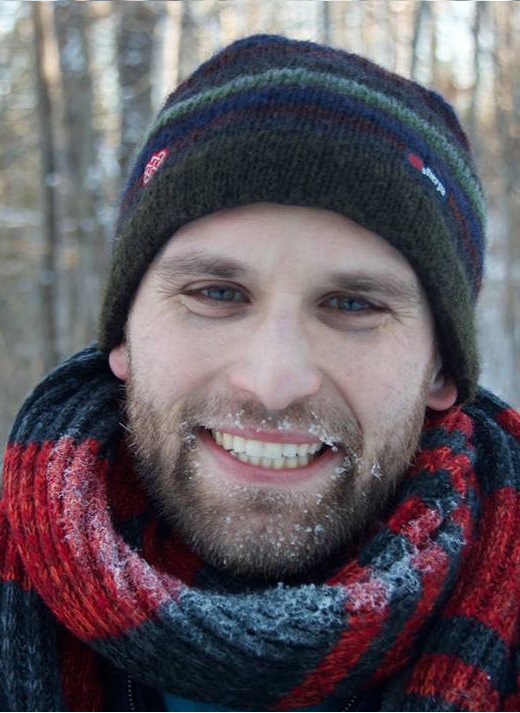
Jahred Adelman
Northern Illinois University, USA

Mike Albrow
Fermi National Accelerator Laboratory, USA
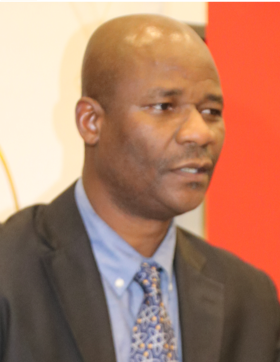
Ketevi Assmamagan
Brookhaven National Laboratory, USA

Vallary Shashikant Bhopatkar
Oklahoma State University, USA
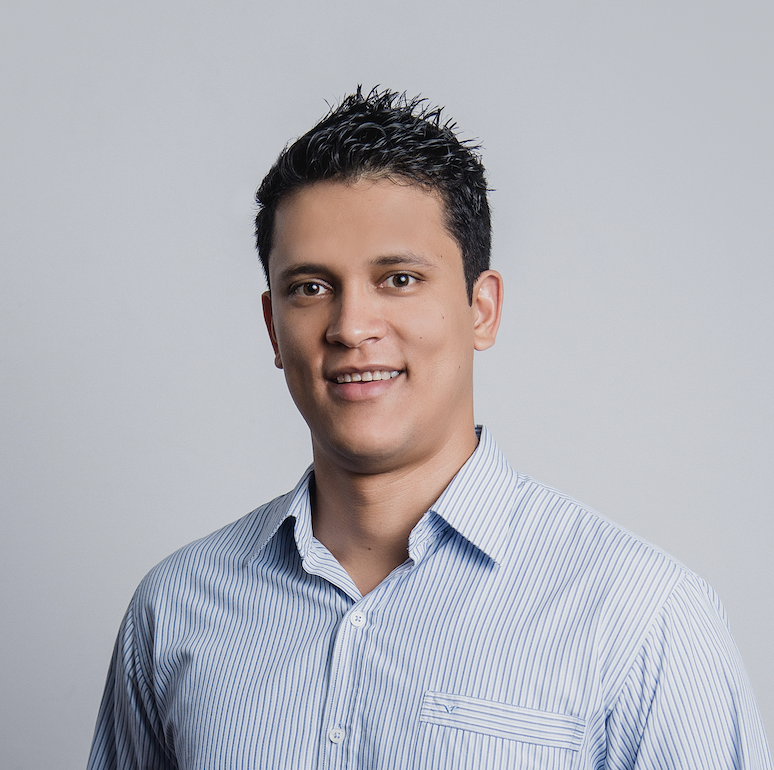
Rodolfo Capdevilla
Fermi National Accelerator Laboratory, USA

Kenneth Cecire
University of Notre Dame/QuarkNet, USA
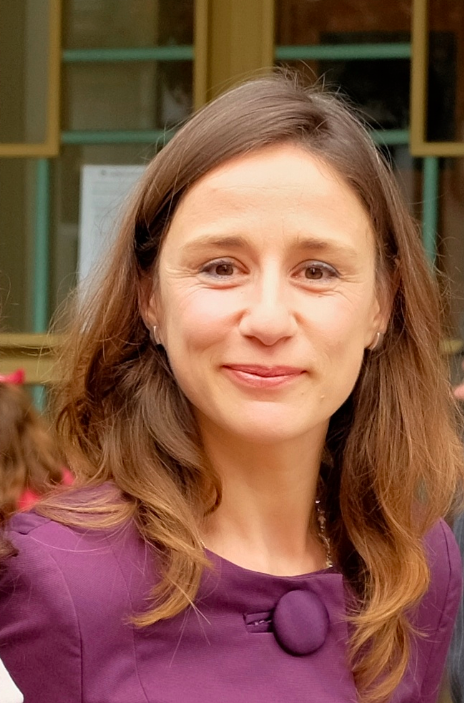
Patricia Conde Muiño
Laboratório de Instrumentação e Física Experimental de Partículas, Portugal

Laura Fields
University of Notre Dame, USA
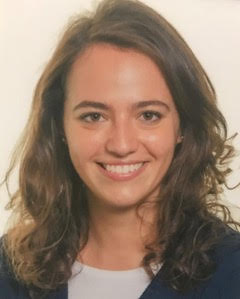
Maria Giovanna Foti
Lawrence Berkeley National Laboratory, USA

Cecilia E. Gerber
Fermi National Accelerator Laboratory, USA

Marla Glover
Purdue University, USA

Allison Hall
United States Naval Academy, USA
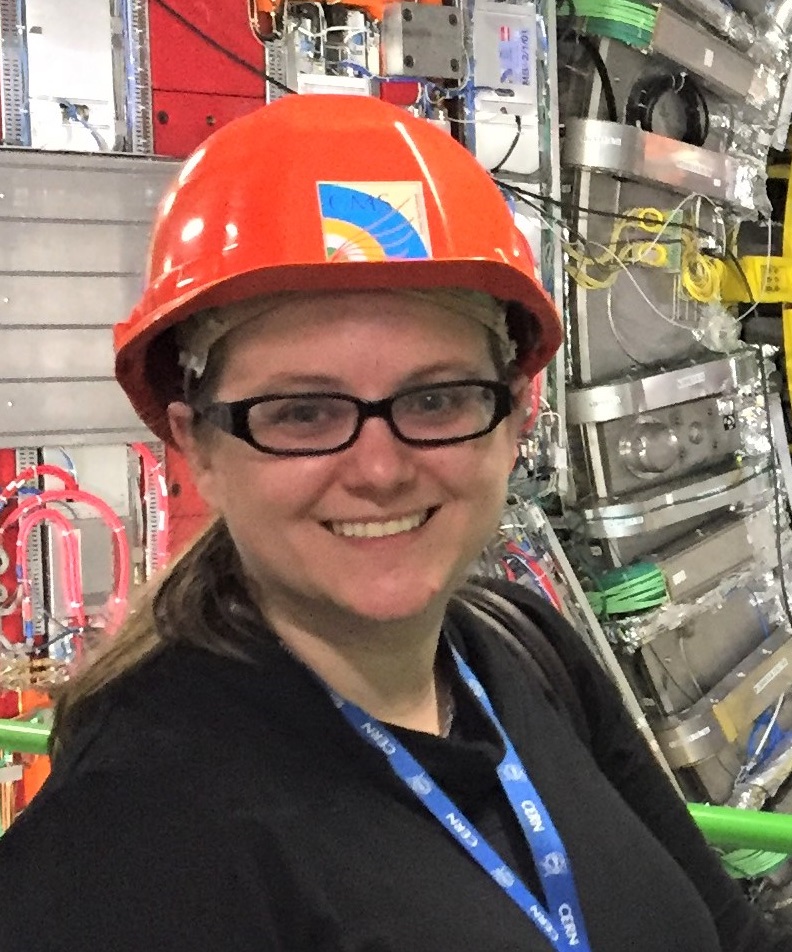
Julie Hogan
Bethel University, USA
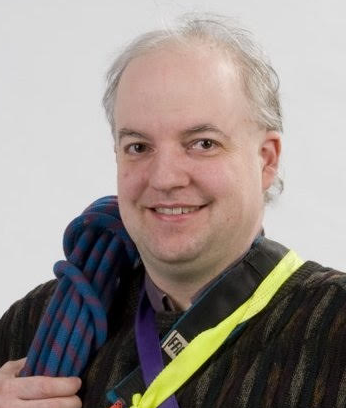
Thomas Junk
Fermi National Accelerator Laboratory, USA
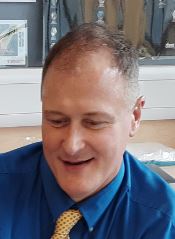
Joel Klammer
Orange Lutheran High School, USA

Sudhir Malik
Universidad de Puerto Rico Mayagüez, Puerto Rico (USA)
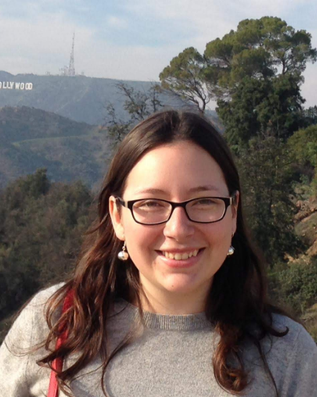
Cristina Mantilla Suarez
Fermi National Accelerator Laboratory, USA

David Martinez
South Dakota School of Mines and Technology, USA

Sonia Natale
CERN, Switzerland
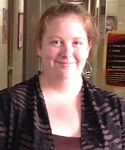
Scarlet Norberg
Fermi National Accelerator Laboratory, USA
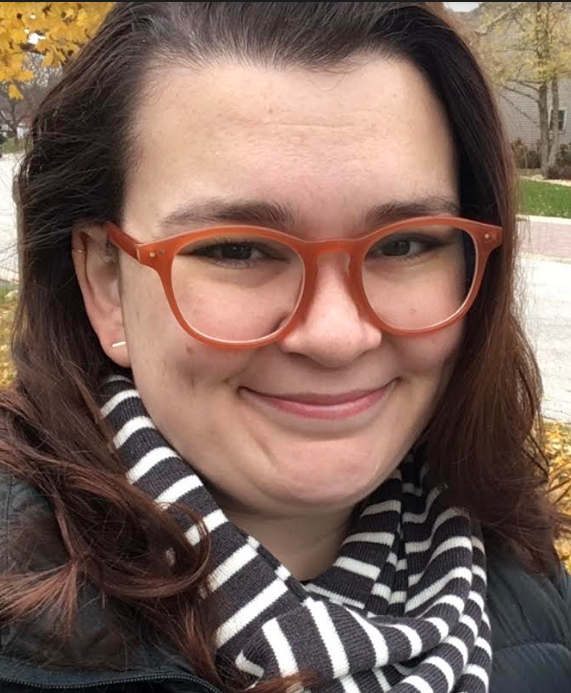
Anne Norrick
Fermi National Accelerator Laboratory, PR (USA)
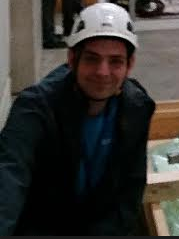
Andrew Olivier
University of Notre Dame, USA
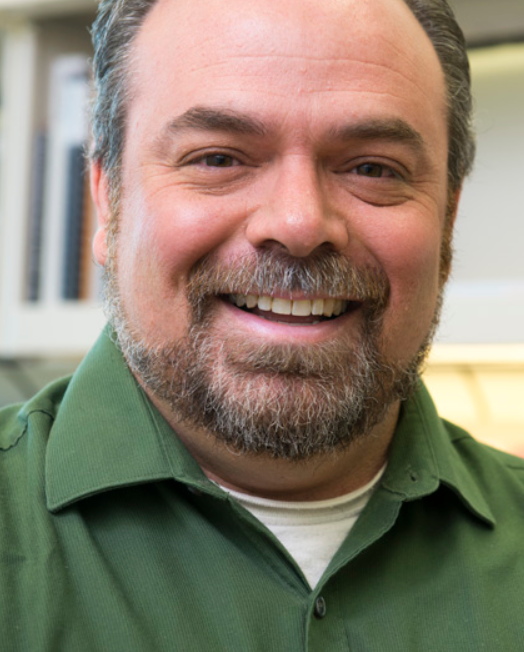
Spencer Pasero
Fermi National Accelerator Laboratory, USA
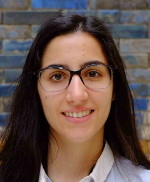
Ana Peixoto
Laboratoire de Physique Subatomique et de Cosmologie (LPSC), France

Rahmat Rahmat
SCC/University of Iowa, USA
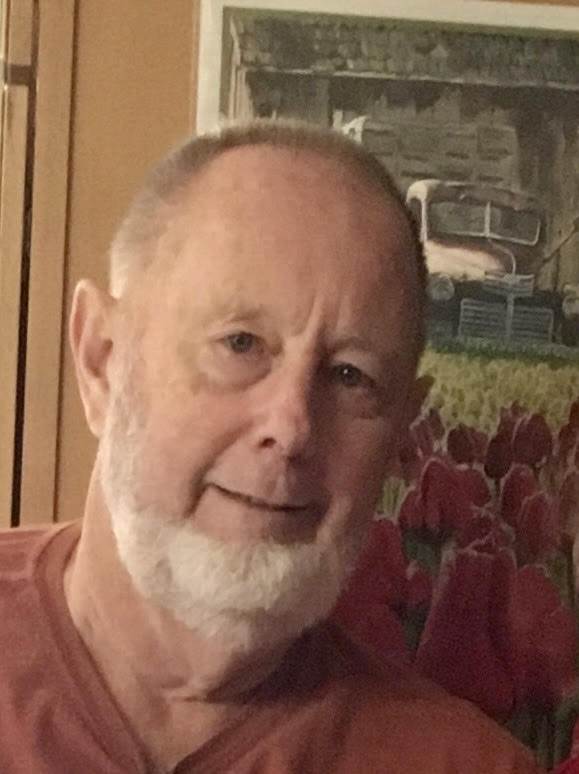
David Trapp
Sequim Science, USA
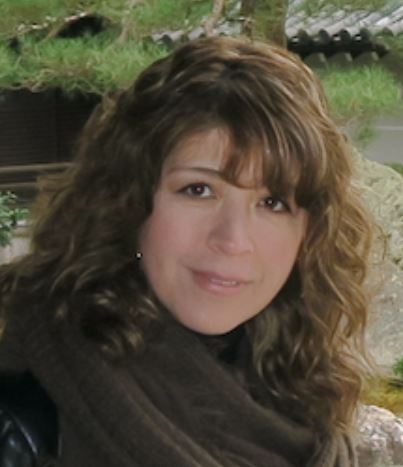
Cecilia Uribe
Benemérita Universidad Autónoma de Puebla, Mexico
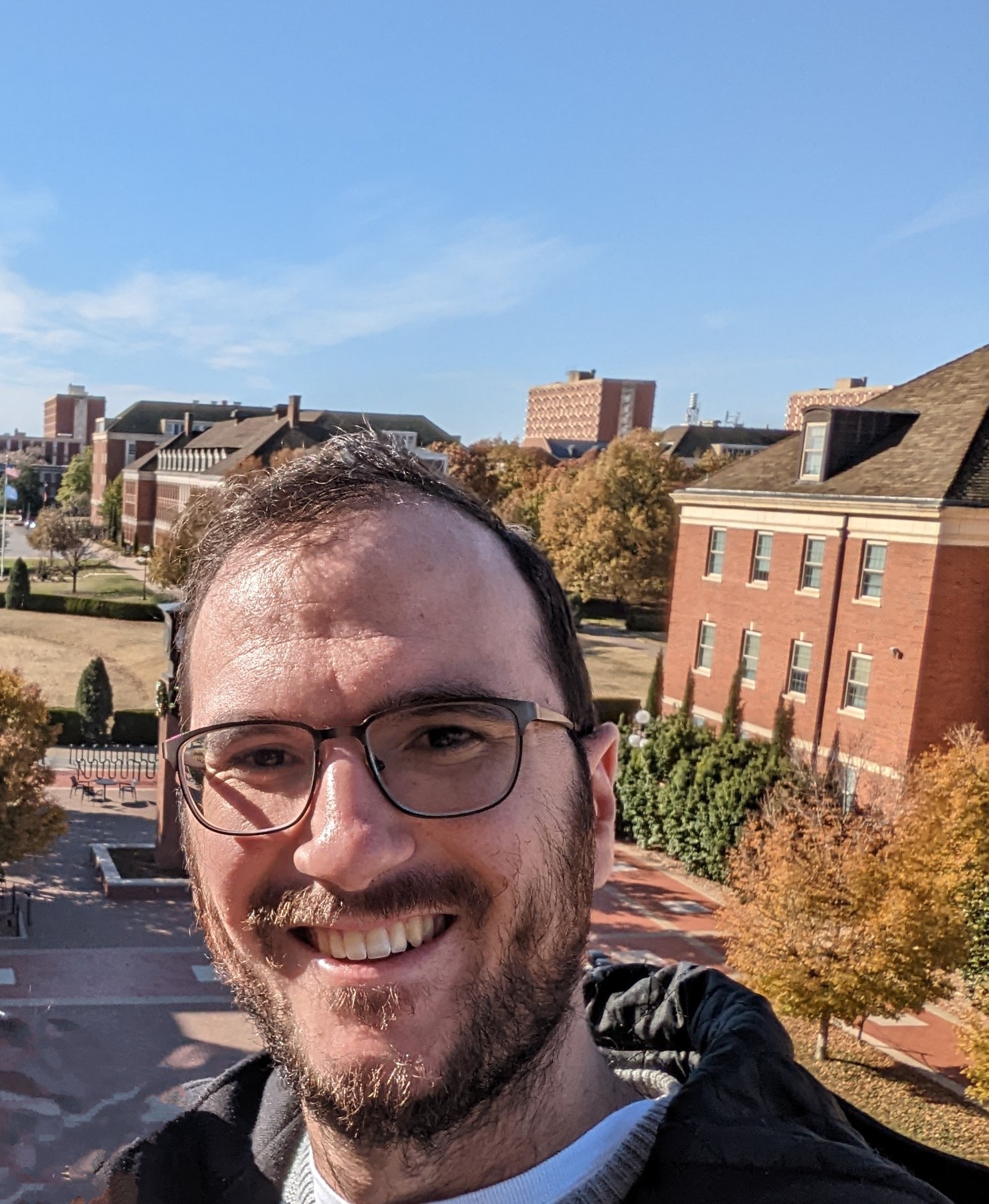
Evan Van de Wall
Oklahoma State University, USA
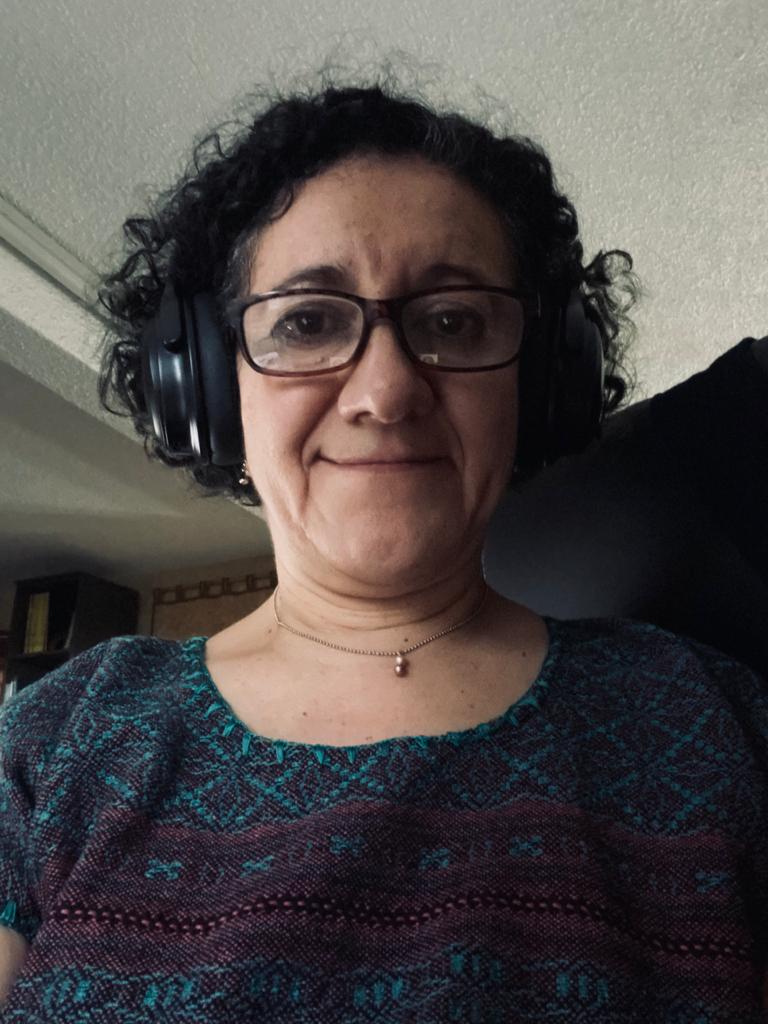
Fabiola Vazquez
Universidad Iberoamericana, Mexico
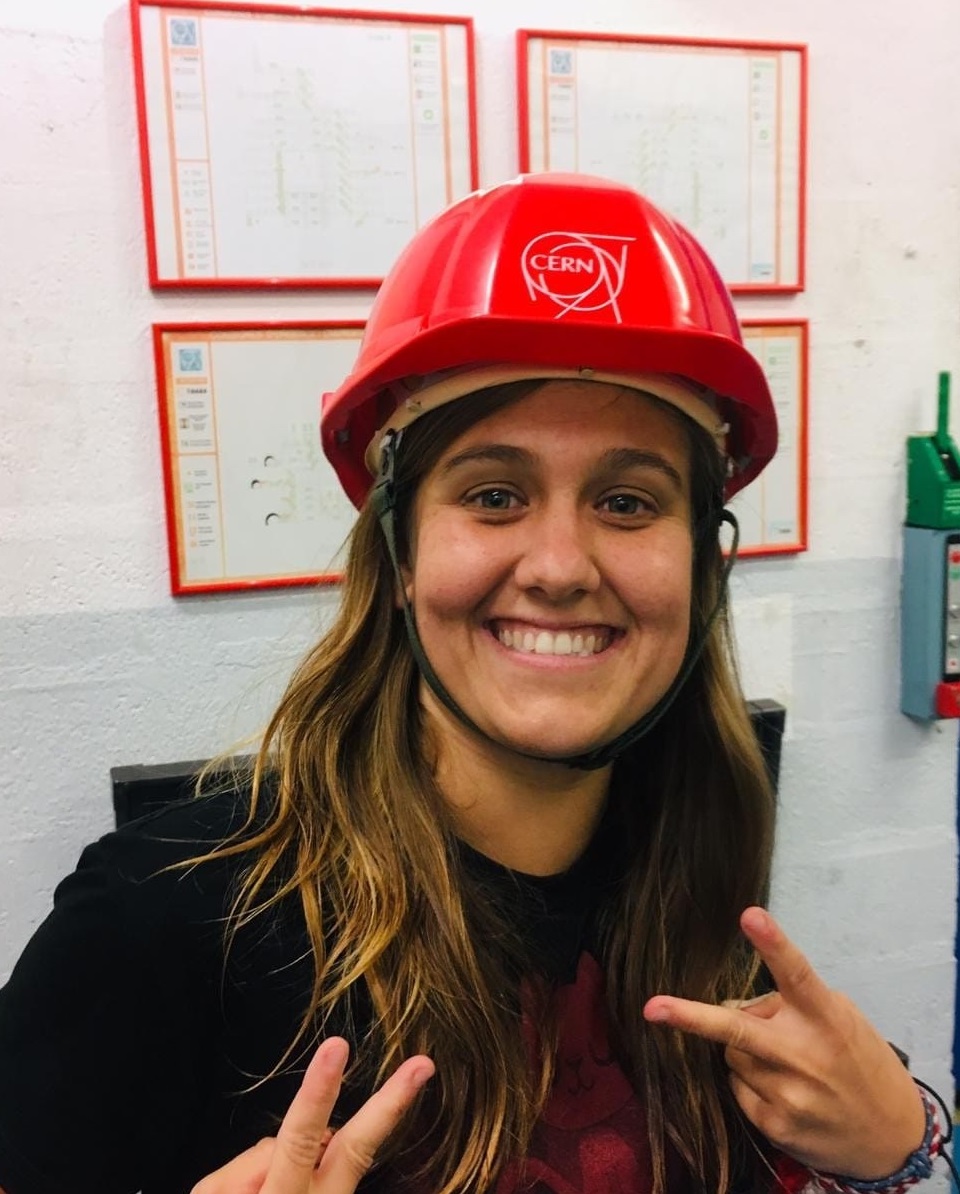
Ana Ventura Barroso
DESY, Germany

Michael Wadness
Medford High School, USA
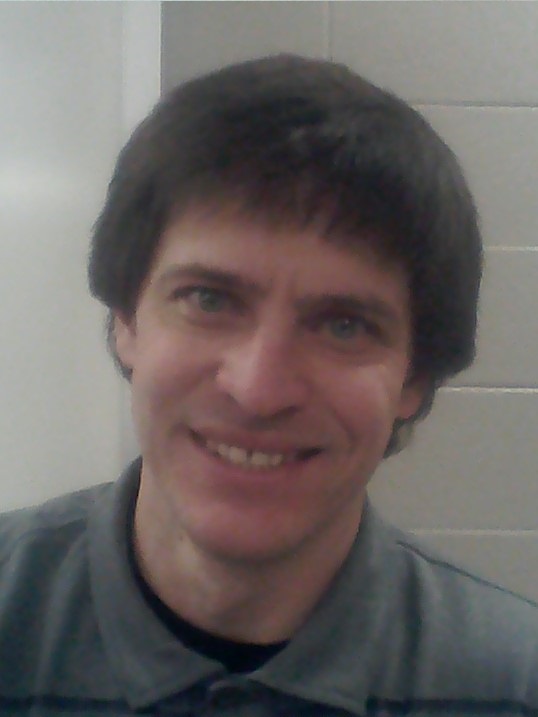
Jeremy Wegner
Winamac Community High School, USA
Susan Wetzler
Plainview-Old Bethpage John F. Kennedy High School, USA

Shane Wood
UMN/QuarkNet, USA
------------------------------------------------------------
MINERvA muon neutrino measurement 2023
Small URL for this page: .
Navigation
- Neutrino Masterclass Project Map
- Screencasts
- Online tools
- Start of masterclass day
- Shift training
- Data analysis
- Understanding results
Remote Masterclass? Students need more prep? Try MINERvA Instructional Screencasts!
First things: prepare ahead
Each computer should have robust internet access. Two students should work together at each computer to complete a 50 events dataset. Before the masterclass, mentors, tutors, and teachers should:
- Schedule and participate in an online Orientation.
- Review the MINERvA Masterclass Documentation and Understanding MINERvA Masterclass Results.
- Try out the measurement. Use the practiceTuples and Practice Spreadsheet.
- Prepare a presentation on particle physics and neutrino experiments.
- Review the MINERvA Masterclass Measurement slides (PPT) (PDF).
- Go over all the steps in this page.
- Prepare and test your Zoom connection.
Students arrive
This should occupy the first 30-60 min
- Registration: please have students sign in on a registration sheet with name, school, and teacher.
- Gateway experience: have a cloud chamber, e/m apparatus, or something similar to whet interest
- Ice-breaker activity: students in small inhomogeneous groups create 1-2 good questions about particle physics, neutrinos, MINERvA, and/or DUNE.
Shift training
Get students ready for their data analysis shift! This will take about 3 hours, though parts of it can be moved to other times of the day.
Mentor presentation, 30-60 min:
- keep it interactive - ask questions about prior experience, shows of hands, wild guesses, etc.
- give students something to touch, e.g. a wave-shifting fiber
- connect to classroom prep
- touch on standard model
- talk about your research
- Focus on theme of MINERvA masterclass: using a neutrino beam from Fermilab to probe the atomic nucleus and better understand weak scattering in preparation for DUNE.
Tour, 30-60 min:
- adds much to the day - often most popular part
- if you have an accelerator to show, great!
- if not: any interesting labs, even if not particle physics, are still great
- have enthusiastic grad students around to chat and explain
Analysis Prep (30-60 min):
- Have a teacher lead this if practical.
- Use/adapt the MINERvA Masterclass Measurement slides (PPT) (PDF).
- Important: go through "masterclass-samples" in ARACHNE Simple on the projector with the students:
- Show students how to navigate to a data file.
- Discuss how to use the tools in ARACHNE.
- Discuss each event in terms of:
- Signal vs. (vertex or recoil) background
- Where the neutrino goes, where the vertex is, muon and proton tracks
- Copying kinematic data to the spreadsheet.
- What we plan to do with the recorded data.
Lunch with a Physicist (30-60 min):
- This is also very popular and a great way for students to interact and get comfortable with scientists.
Data Analysis
This is the heart of the masterclass and takes about 60 min. There should be 2 students at each computer, cooperating to get their data measured. Mentors, tutors, and teachers should circulate to help the students analyze the events and work out any problems they have. Don't give them answers. Help them figure things out and learn to see data as scientist does.
- Instructional Screencast
- Student Start Page - give students http://tiny.cc/m-go-pg.
- Cheat Sheet
Data Assignments 2023:
International Masterclasses
| Date/time CT | Institute (Data Group) | Institute (Data Group) | Institute (Data Group) | Spreadsheet |
|---|---|---|---|---|
| Sat 04 Mar/15:00 | FtCollins (A, B) | FNAL-04Mar2023 | ||
| Tue 07 Mar/15:00 | Lead (C) | FNAL-07Mar2023 | ||
| Fri 10 Mar/09:00 | Valencia (A B C D) | FNAL-10Mar2023 | ||
| Wed 15 Mar/12:00 | Canandaigua (C) | FNAL-15Mar2023 | ||
| Sat 25 Mar/08:00 | Constantine (B, D) | Kolkata (A) | FNAL-25Mar2023-1 | |
| Sat 25 Mar/14:00 | Duluth (A) | Mayaguez (C) | Piscataway (B,D) | FNAL-25Mar2023-2 |
*no videoconference
If >50 students are expected, contact Masterclass Coordination for more data groups.
All MINERvA Data for International Masterclasses:
- mergedTuples 1-25
- mergedTuples 26-50
- mergedTuples 51-75
- mergedTuples 76-100
- mergedTuples 101-125
- mergedTuples 126-150
- mergedTuples 151-175
- practiceTuples (includes teacherTuple and Archive)
Each mergedTuple has ~50 "gates" with multiple events. The student must find the useful event, if it exists, in each gate.
Sharing Results
This takes a little over one hour. Both parts are important.
Discussion (30-45 min):
- Mentor leads, students interact.
- View and discuss combined plots for your institute in spreadsheet.
- Student/small group discussion questions (version 1) - make a copy of this Google doc
- Student/small group discussion questions (version 2) - make a copy of this Google doc
- Student/small group discussion questions (version 2) - PDF
- Help students analyze histograms to find:
- Neutrino beam momentum and energy
- Uncertainty in px and py
- Estimate of carbon nucleus radius using Uncertainty Principle and Fermi Gas approximation
- Discuss meaning of result for understanding nucleus and weak scattering.
For more information, see Understanding MINERvA Masterclass Results.
Videoconference (30-45 min):
Connecting to videoconferences:
Course of a videoconference:
- Connect to videoconference link or Indico page (see above).
- Someone should log into the videoconference 15 min early to be sure the connection is established. See the Schedules page.
- Follow the agenda on Indico:
- Introductions and warm-up
- Institute results
- Combined results
- Discussion, Q&A, and wrap-up
- It is good to have a student spokesperson but try to arrange so it is not too hard for another student to make a comment or ask a question.
After this, we have post-discussion and closeout.
Before you go home:
Please report your attendance numbers on our Attendance Form!
We ask teachers, tutors, and mentors to fill out a short survey within a day or two after the masterclass.
Have a great day!
------------------------------------------------------------
MINERvA Masterclass Documentation
External Links:
- MINERvA Masterclass website
- MINERvA masterclass guide
- Neutrino Masterclass Library
- International Masterclasses
- PDF of this page
MINERvA Masterclass Measurement
Created by K. McFarland, K. Cecire, R. Fine, M. Carneiro, N. Tagg, QuarkNet LHC-Neutrino fellows
The MINERvA masterclass measurement is supported for International Masterclasses.
Contents:
- Description
- Requirements for hardware and software
- Outline of the day
- Pedagogy
- Student procedure
- Presentation of results
- Sample questions
- Moderators
- Material for students and teachers

(Credit: Fermilab)
Description
The MINERvA masterclass measurement enables students to examine actual events from the MINERvA detector in the MINOS neutrino beamline at Fermilab and draw conclusions based on categorization of the data and the kinematics of the interactions. There are both background and signal events. In each signal event, a neutrino penetrates a nucleus in a carbon target and undergoes a weak interaction with a neutron in that nucleus:
νμ + n0 → μ- + W+ + n0 → μ- + p+ .
In short, the neutrino interacts with the neutron to become a muon, causing the neutron tobecome a proton. (Note the net change in charge is zero.) The interaction is mediated by a W boson. The resulting muon and proton exit the nucleus with considerable momentum, which came from the original neutrino. While MINERvA cannot directly detect the neutrino, it can detect and measure the kinematics of both the muon and the proton that emerge from the interaction.
Students can find this kinematic information the ARACHNE, the MINERvA event display that they use to visualize the events. The students can then put this inofrmation into a spreadsheet which applies conservation of momentum to give the momentum of the system prior to the interaction in three dimensions. The z-direction is, in the coordinate system of the experiment, the initail beam direction. The initial momentum in z is the momentum of the neutrino plus the momentum of the neutron, if any, before the collision. The momenta in x and y, then, if there is any, would be due solely to the neutron.

Part of MINERvA signal event as seen in ARACHNE.
For more details, see Undertanding MINERvA Masterclass Results.
Software/Hardware
The entiire MINERvA masterclass measurement runs online in a browser. Masterclass leaders should test ARACHNE (including choosing a track and copying kinemetics) and Google Sheets in the computers and browsers to be used ahead of time.
Masterclass General Plan
All masterclasses share a pattern for the masterclass day. Neutrino masterclasses are no different in this case. The main elements of the plan are:
- Intro/warmup
- Introduction to the physics (neutrino physics , weak interactions, MINERvA experiment)
- Lab tour, if available
- Introduction to the masterclass measurement (ARACHNE, student spreadsheet, how to measure)
- Lunch with physicists
- Masterclass measurement
- Discussion of results
- Videoconference.
For neutrino masterclasses in particular, these resources will help:
- Particle cards activity
- Template for introduction to neutrino physics
- Template for introduction to measurement
- Notes on measurement (below)
- Notes on videoconferences.
Pedagogy
Enduring Understanding:
Indirect evidence provides data to study phenomena that cannot be directly observed.
Objectives:
- Apply conservation of momentum and energy to measure the approximate energy of a neutrino beam from the Fermilab accelerator complex.
- Apply conservation of momentum and energy to measure the properties of neutrons in nuclei of atoms in the target of a neutrino beam.
- Determine which events are signal events from which effective measurements may be made and which events are background that cannot be used for measurements.
Student Procedure
Screencast: https://tinyurl.com/minerva2019mc.
Here is the general outline of what the students do:
- Students work in pairs: two students to one computer.
- Each pair of students is assigned one mergedTuple (a 50-event dataset) from a Data Group assigned to their masterclass from the Data Analysis section of the MINERvA page of the Neutrino Masterclass Library,
- Students examine each event to determine if it is signal or background.
- If the event is determined to be backround, the students skip to the next event.
- If the event is a signal event, students move the cursor to each of the two tracks that emerge from the vertex and choose them. Momentum and kinetic energy data will appear for the track. Students can copy this data and paste it into an online spreadsheet.
- Note: Each masterclass is assigned a sheet in Google sheets. This means:
- The masterclasses that will meet together in a particular videoconference are all assigned the same instance of Google Sheets with a unique URL. Thus, if Boston, Prague, and Mazabuka are meeting in a videoconference, they get their own place Google Sheets.
- Each masterclass then has its own individual sheet inside that place. It is located as a tab at the bottom and is marked with either its assigned mergedTuples or the location, e,g, Boston. The students in Boston put their data, line-by-line, according to their mergedTuple and the Entry (event window, called a Gate), into their sheet in their tab. (This is pasted from the event display.)
- The spreadsheet will calculate pz (in the beam direction), py, px, and pt (transverse momentum calculated from px and py).
- The sheet combines student data to make a histogram of values of pz. Each value of pz represents the momentum of the neutrino before the interaction plus the moemntum of the taget neutron in the z-direction, if any. Guided by the masterclass leader, students can make a histogram of pz for all of their events.
- Students make similar measurements of px and py. Since they are transverse to the beam, they represent components of the momentum of the target neutrons only, if there is any.
Main steps for students in data analysis:
First step: Find events.
Each pair of students goes to the Student Start Page where they find their assigned Data Group and spreadsheet.
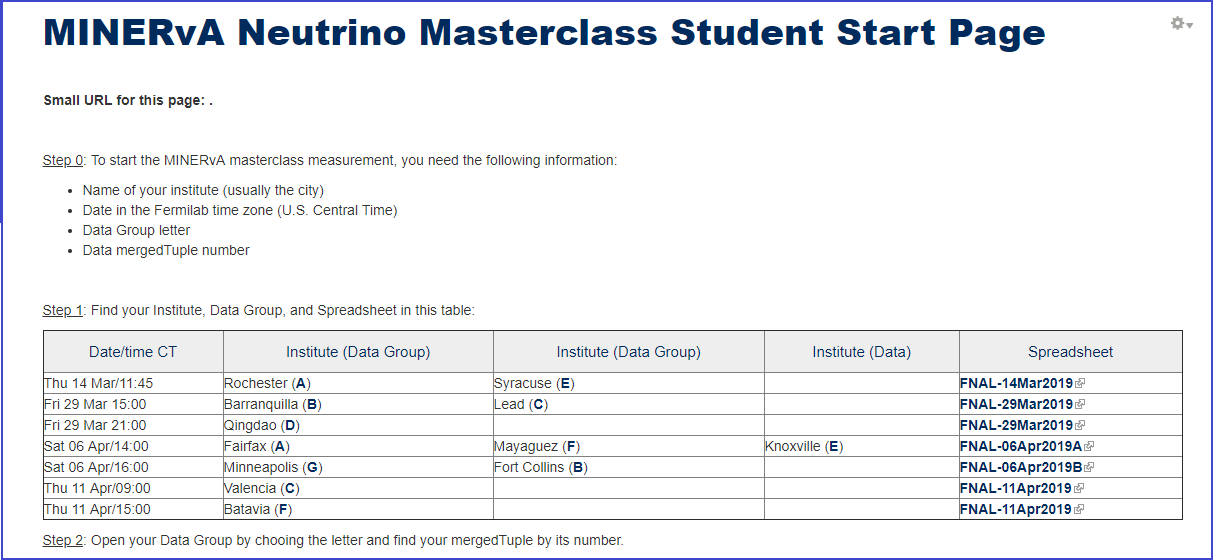
Second step: Open and use Arachne.
The masterclass leader should tell each pair of students their mergedTuple and help them find it in the data group and spreasdsheet . When they choose the mergedTuple, Arachne will come up in a new tab on the browser, which will open at the initial time Slice in the first Gate (shown as Entry 0; the next Gate will be Entry 1, etc.). In most cases, it will not initially show the event for which the students are looking. They must find it, if ti is there, by advancing from Slice to Slice within the Gate.
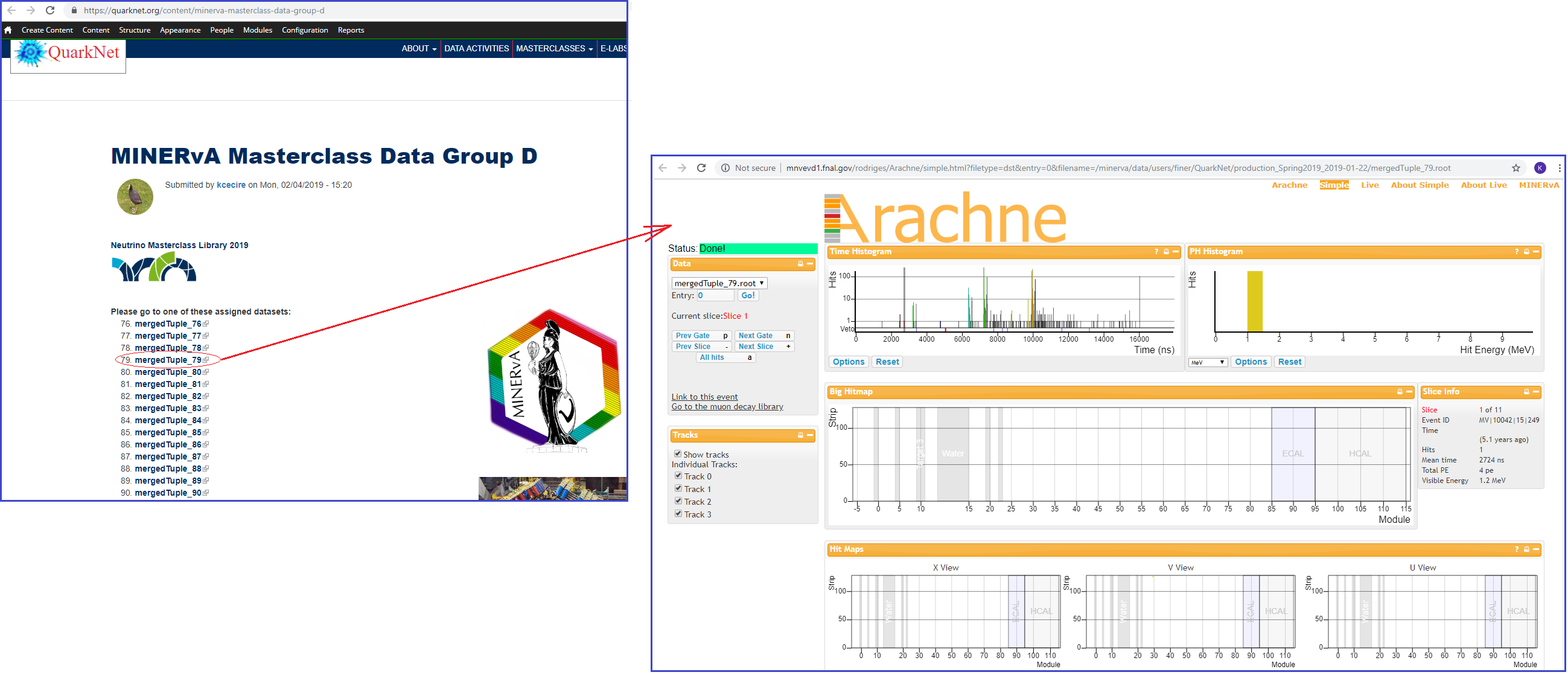
Students choose Next Slice, which moves a slightly later time in the Gate with each click. The progress can be seen in the Time Histogram in Arachne. Students advance the Slice until they find an instaance of one long track and one short track coming from a common vertex. This is the actual event theyi seek.
In this particular Gate, we find two possible events but both are background. The first has two short tracks rather than one:
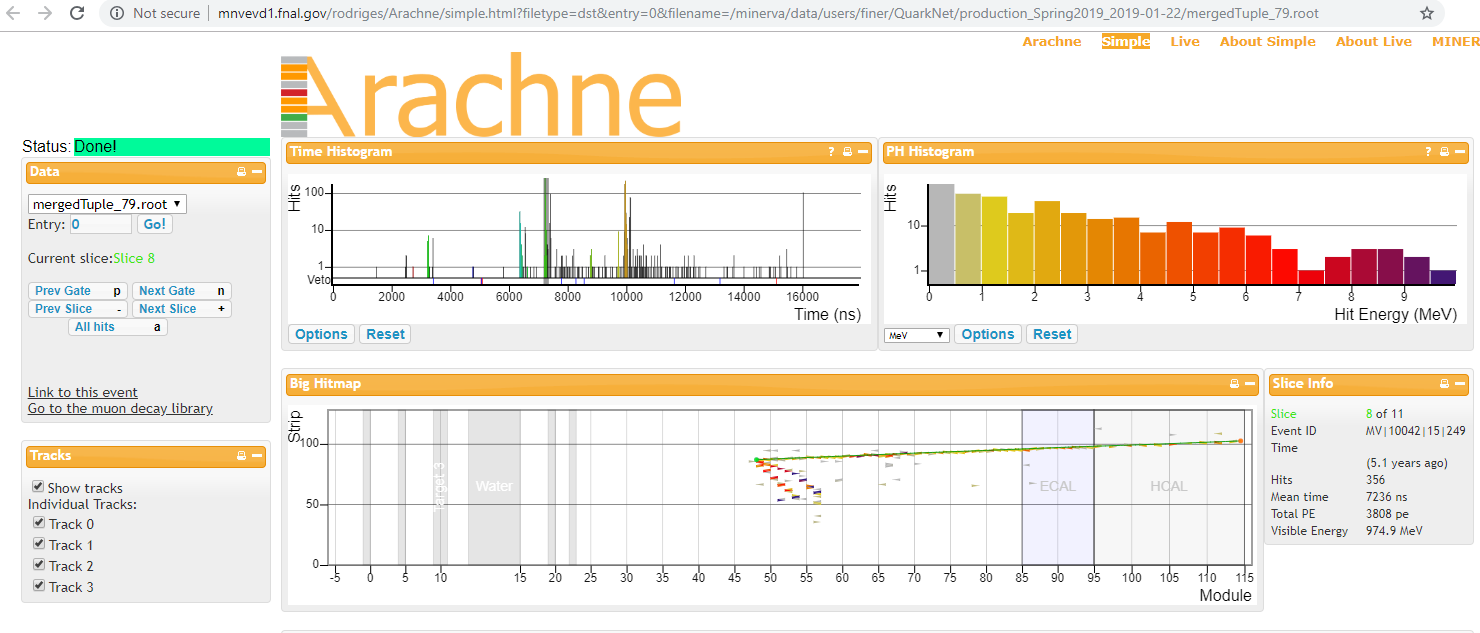
That means is is not a signal event. Note that time has progressed to a little over 7000 ns in the Time Histogram. This is also background from a later Slice in the same Gate:
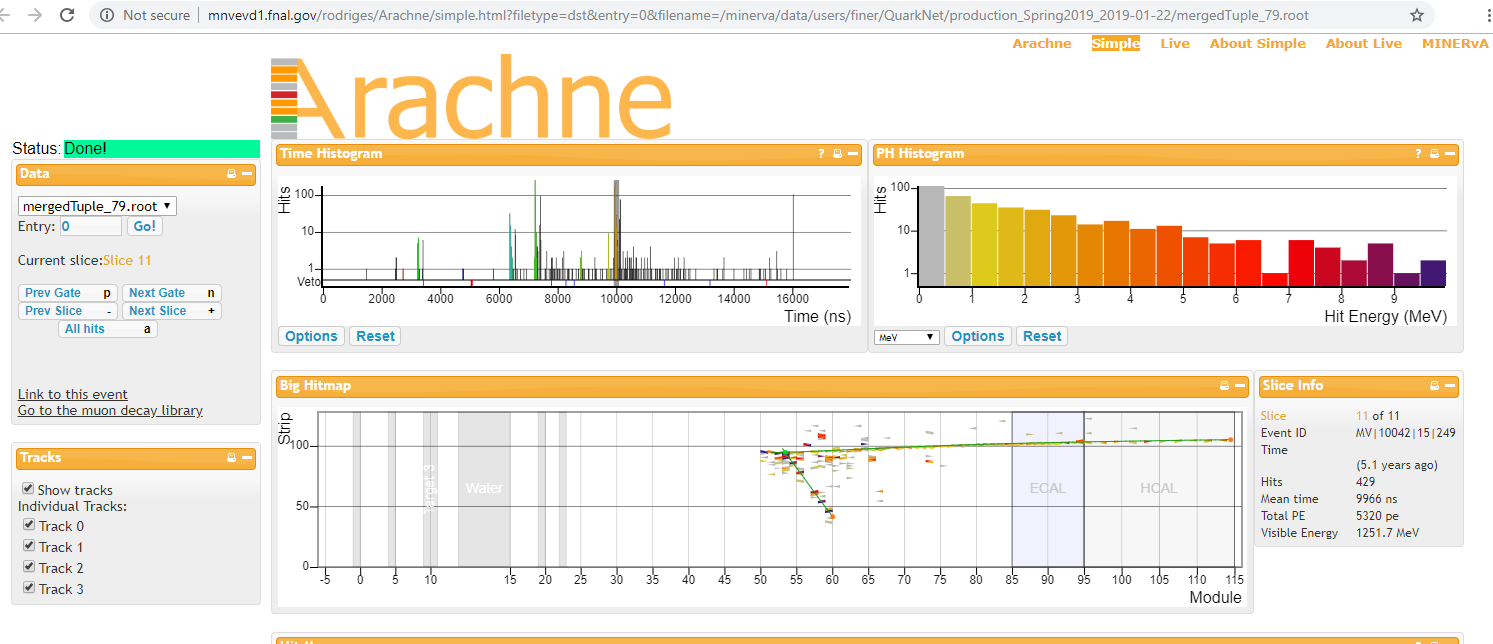
This not only has a an extra track which appears to go backwards (negative z direction) from the vertx but several lines of red and orange dots also coming from the same place.
Here is an example of a good signal event:
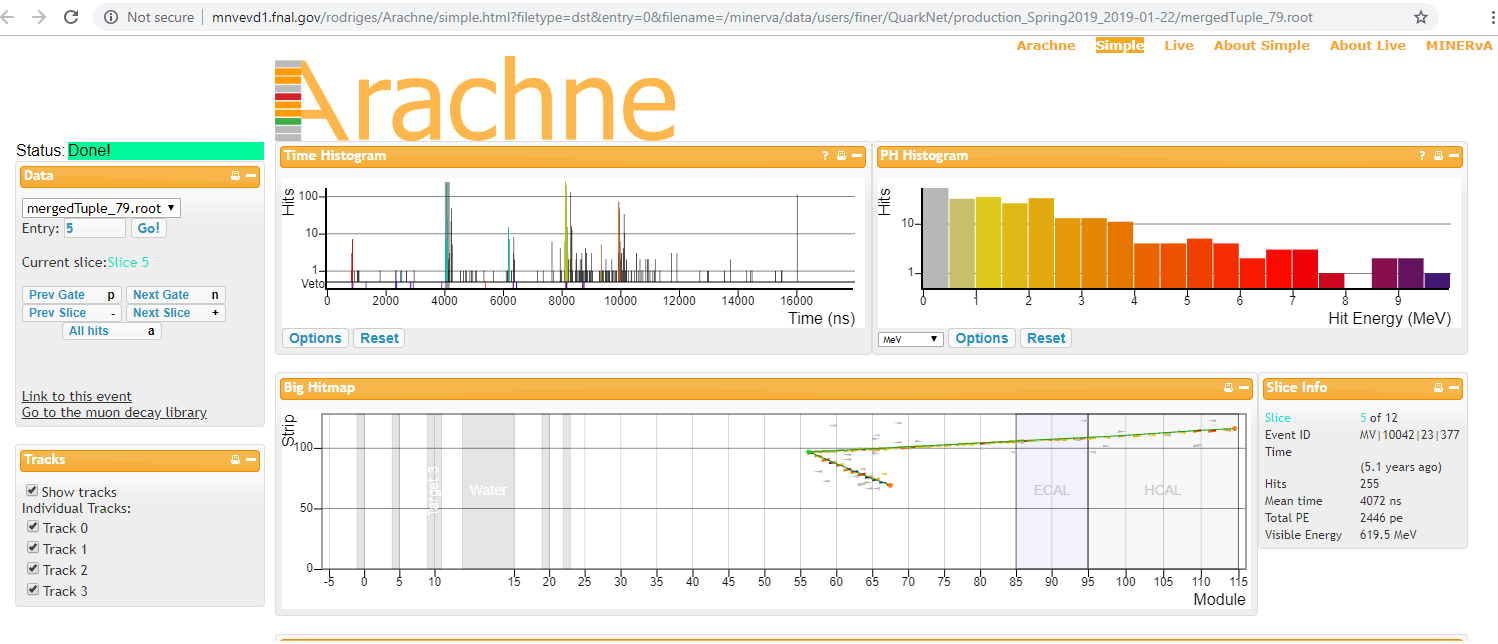
Note we are in a different Gate. This is close to a "classic" event: one clear long track for the muon and one clear short track for the proton. (The muons track is always the longer of the two.)
Now the students can find the kinematics from each track. First, they choose one of the two tracks. Here we picked the long muon track first:
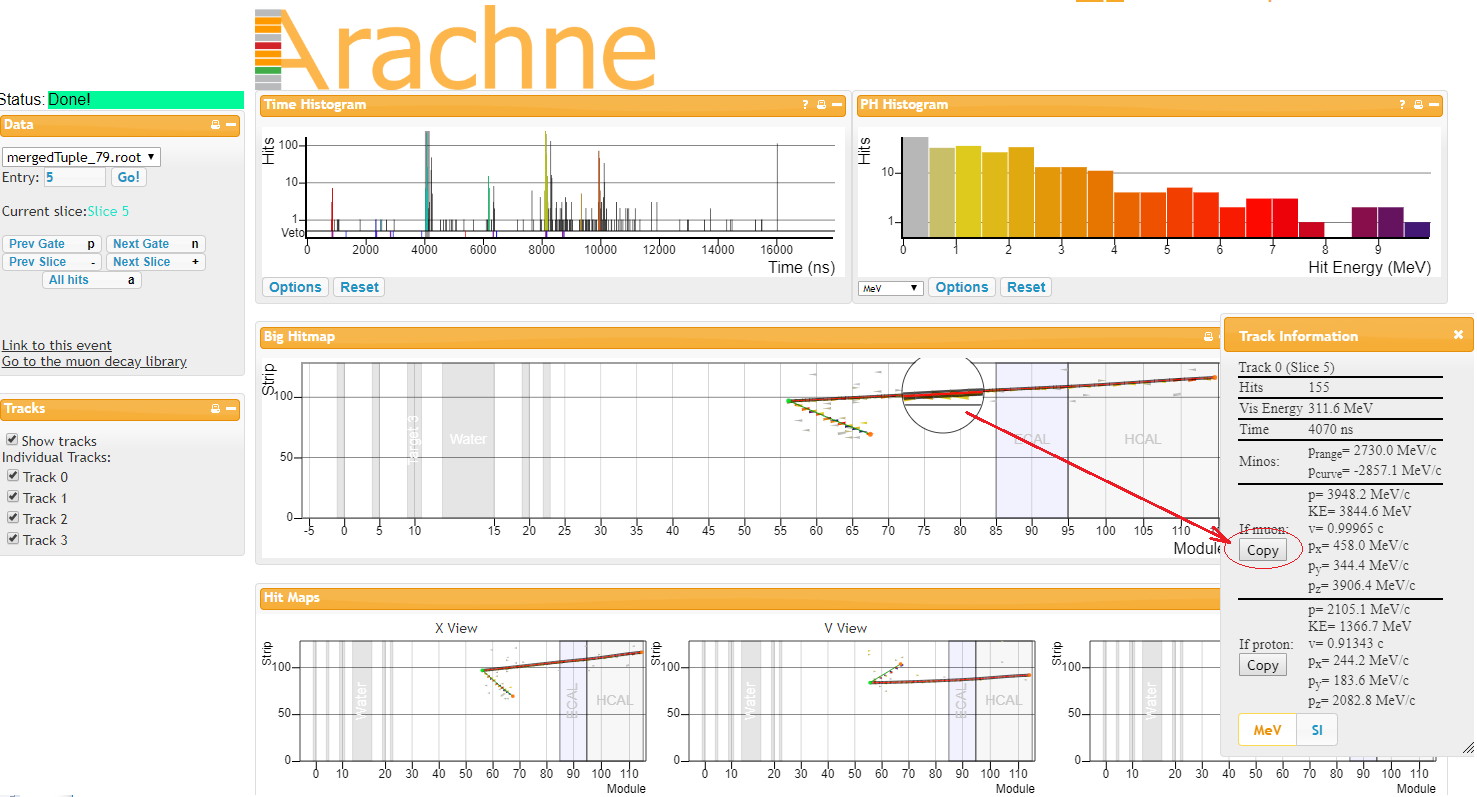
Third step: Enter data into the spreadsheet.
When students choose a track, the Track Information box pops up. Because this is a muon, they choose the Copy button for a muon. This copies the kinematic data for the muon onto the computer clipboard. It is then pasted at the appropriate place in theie assigned Google sheet, in this case in the row for mergedTuple 79, Entry 5 and in the column under Muon KE (MeV):

The students next choose and copy for the proton:
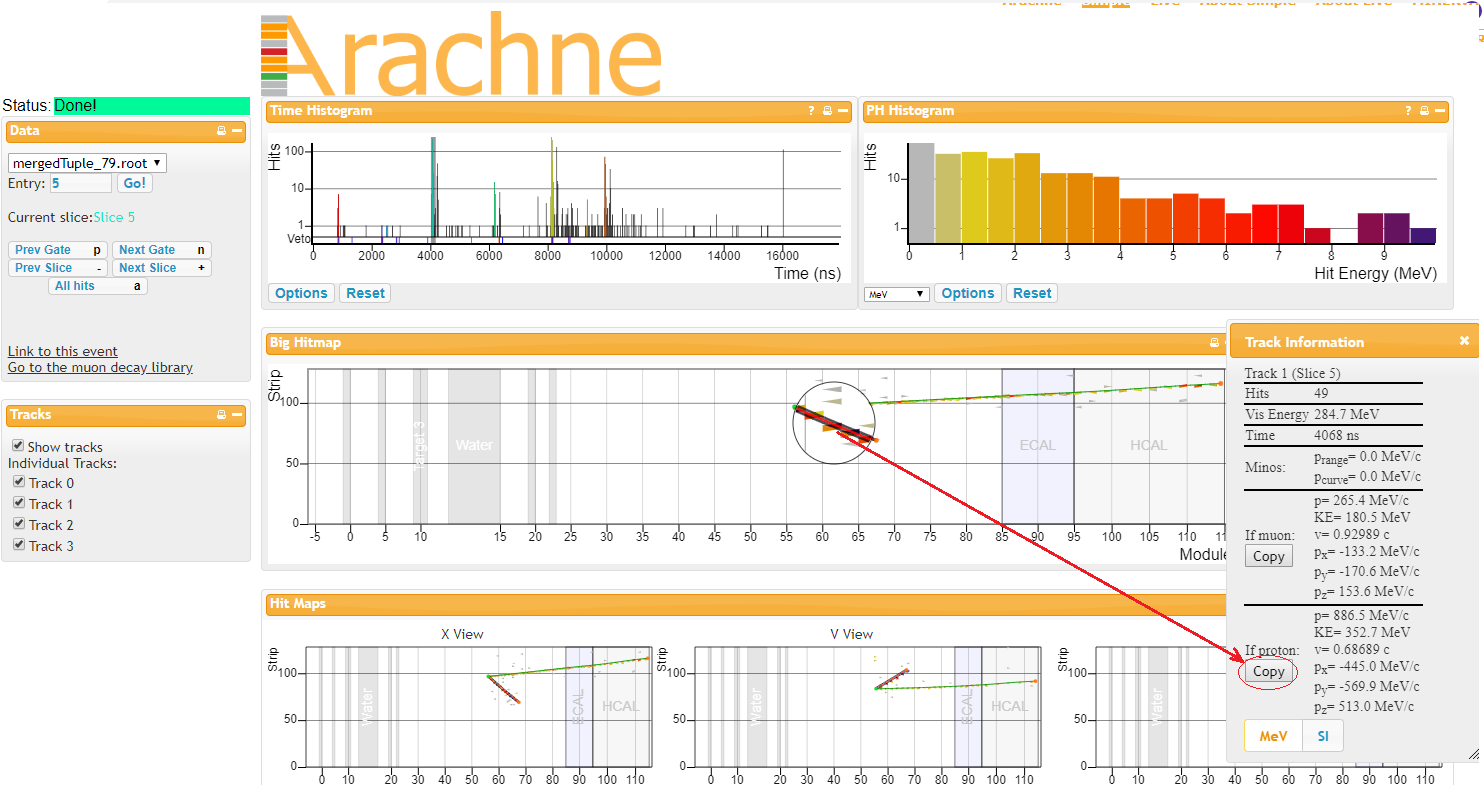 Then paste the proton kinematics in the next cell to the right of the muon numbers:
Then paste the proton kinematics in the next cell to the right of the muon numbers:
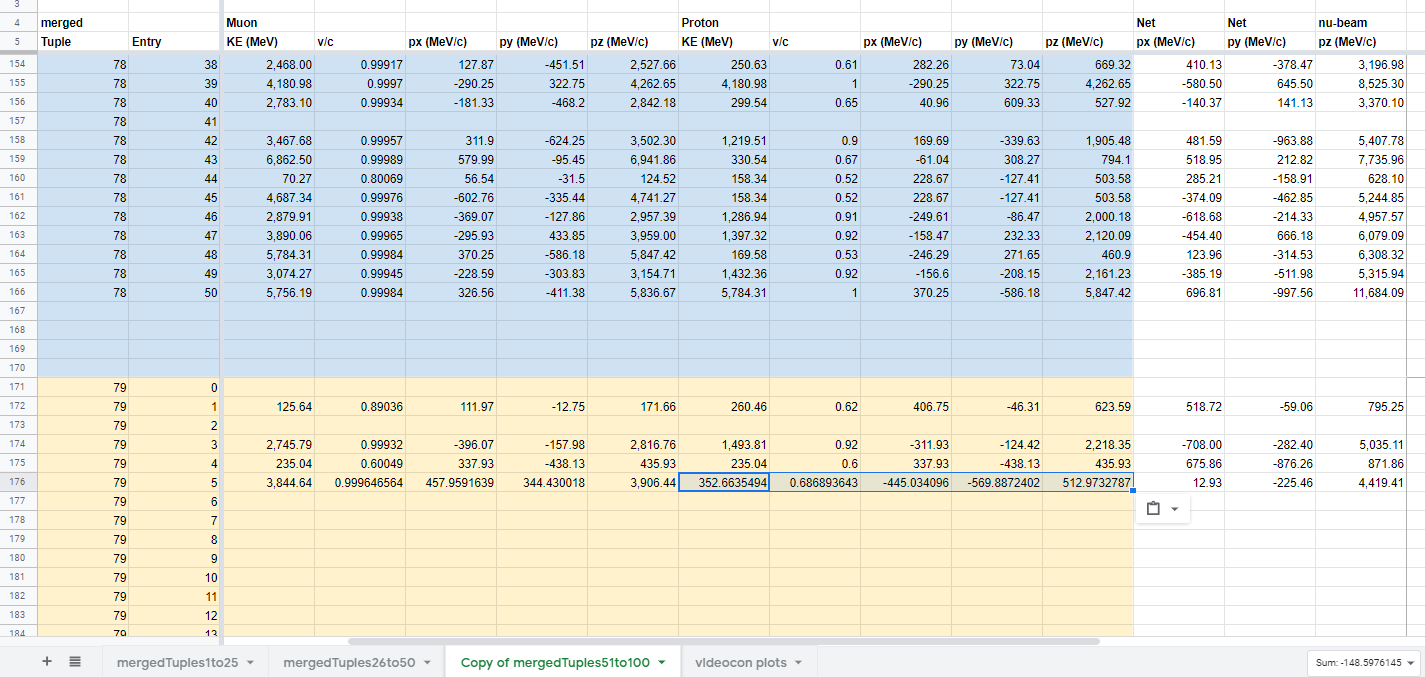
Note that the spreadsheet automatically calculates initial px, py, and pz.
Students do this for all 50 entries (or gates), leaving empty rows only when the gate has no veriable signal event.
About background events
Signal events have a "clean" vertex and undiverted tracks for a proton (short track) and a muon (long track). There may be some splotches of light gray near the vertex; these are low energy deposits in the detector and can usually be ignored.
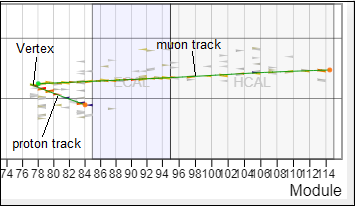 | 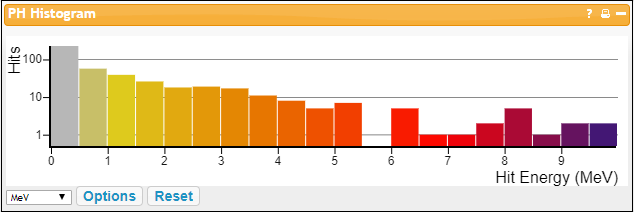 gray to red to blue. |
The two main types of backround event are Vertex and Recoil.
- Vertex background events have ejecta from or near the vertex of the long muon track and short proton track which frustrate an attempt to accurately measure momentum and energy.
- Recoil background events have muon or proton tracks which show signs of having radiated an unseen particle or collided with an unseen particle. The main sign of this would be a track with a "knee" or a "kink" in its path.
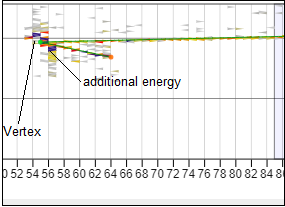 | 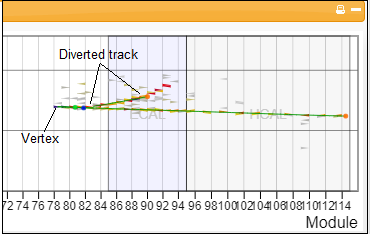 |
In addition, many background events are just outside parameters for a signal event. They may have too many tracks or many "splotches" of significant extra energy or are simply hard to understand. (Physicists usually call these latter kind, if they are odd enough, "zoo" events.)
The good news: students do not need to categorize background events - just skip them!
Presenting and Understanding Results
Masterclass leader must help students to interpret results in a physics discussion after the measurement. We refer you again to Understanding MINERvA Masterclass Results.
For each masterclass, plots of pz, px, and py for all signal events measured will appear at the bottom of the specific sheet in Google Sheets used by that masterclass. Each plot should be roughly Gaussian. Masterclass leaders should guide students to these 3 discoveries:
- The central value in the pz plot represents the beam momentum. Since each neutrino has very little mass but significant-enough momentum to be relativistic, pz in MeV/c is effectively the same number as energy E of the neutrino beam. If nothing else, the students will leave the mastecrclass knowing the MINOS neutrino line beam energy becuase they will have measured it.
- The values of px and py represent neutron momenta in the x- and y-directions, transverse to the neutrino beam. If these cluster narrowly around zero, then the neutrons are at rest when they interact with the neutrinos. If there is more like a Gaussian distribution, they hav etheir own momenta inside the nucleus. Thus students can conclude from a robust distribution that the neutrons do indeed have their own momenta - and thus motion - inside the nucleus.
- The widths of the distributions in px and py represent two meaurements of the uncertainty in the momentum of the neutron inside the carbon nucleus. Application of the Heisenburg Uncertainty Principle will then yield the uncertainty in position. An adjustment for the neutrinos behaving approximately as a Fermi gas doubles this number. This is the uncertainty in the position of the neutron and should be on a scale similar to the radius of a carbon nucleus.
The plots should appear at the top of the sheet to the right of of the data and look something like this:
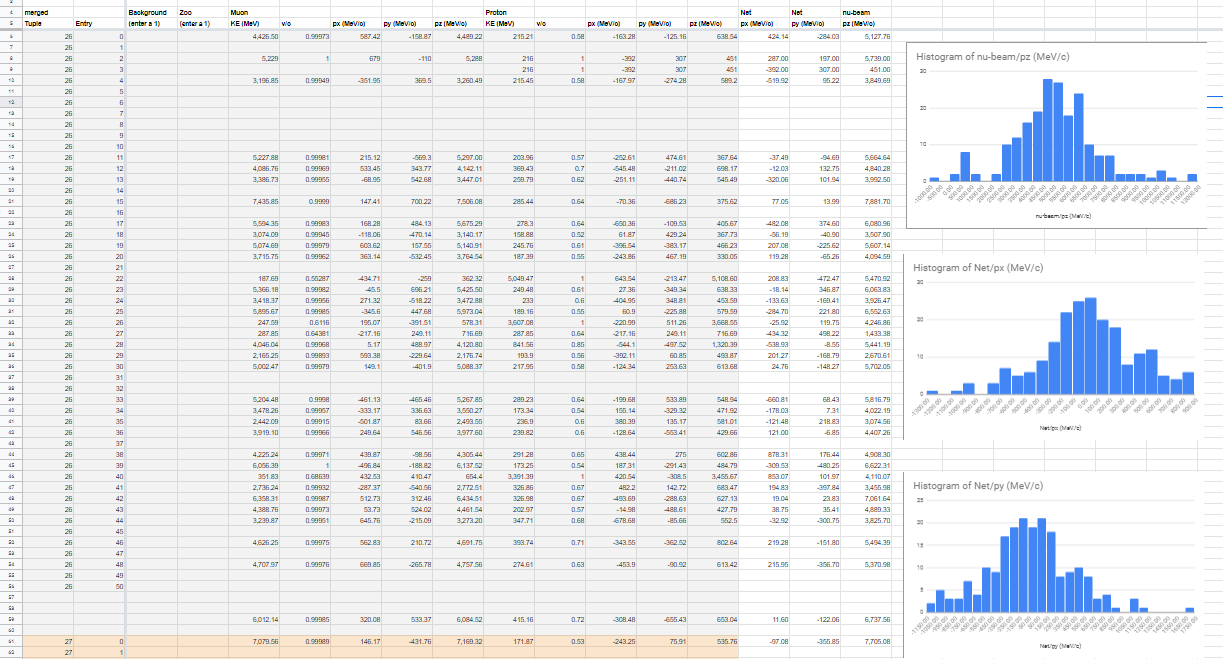
For px and py, the uncertainties can be roughly measure as the full-width at half-maximum of the plot.divided by 2. Students and masterclass leaders are asked to measure these from the plots and enter these into the Google sheets just below those plots.. The Google sheet will then make the cal
Much MINERvA research is dedicated to understanding the full interaction - νμ + n0 → μ- + p+ plus whatever interactions the muon and the proton have with other parts of the nucleus as they energy.
Moderators
Fermilab-based moderators should refer to the FNAL Masterclass Moderators page.
All moderators should note the following:
- The videoconference should last about 30 minutes. It sometimes runs over but be careful to not use up too much time, especially in the first half. Keep answers and explanations brief and to the point. Do not veer off into details or additional related physics.
- If there is only one masterclass group assigned to the videoconference, there is no need for combination of results. Rather, allow the single group to explain their results to you; ask probing and encouraging questions.
- If there is more than one group, still allow each group to explain their result but limit it to only 1-3 minutes. Ask questions.
- Combination plots are in the "videocon plots" tab of the Google Sheet. The spreadsheet calculates standard deviation for the px and py plots as well as Δpx, Δx. Δpy, and Δy. Please discuss these results with the students and compare them with the results for a single group. Ask more questions.
- The last part of the videoconference is for students to ask questions of you. Be sure there will be time for this. They are instructed to be wide-ranging in their questions.
The plots and calculations look like this:
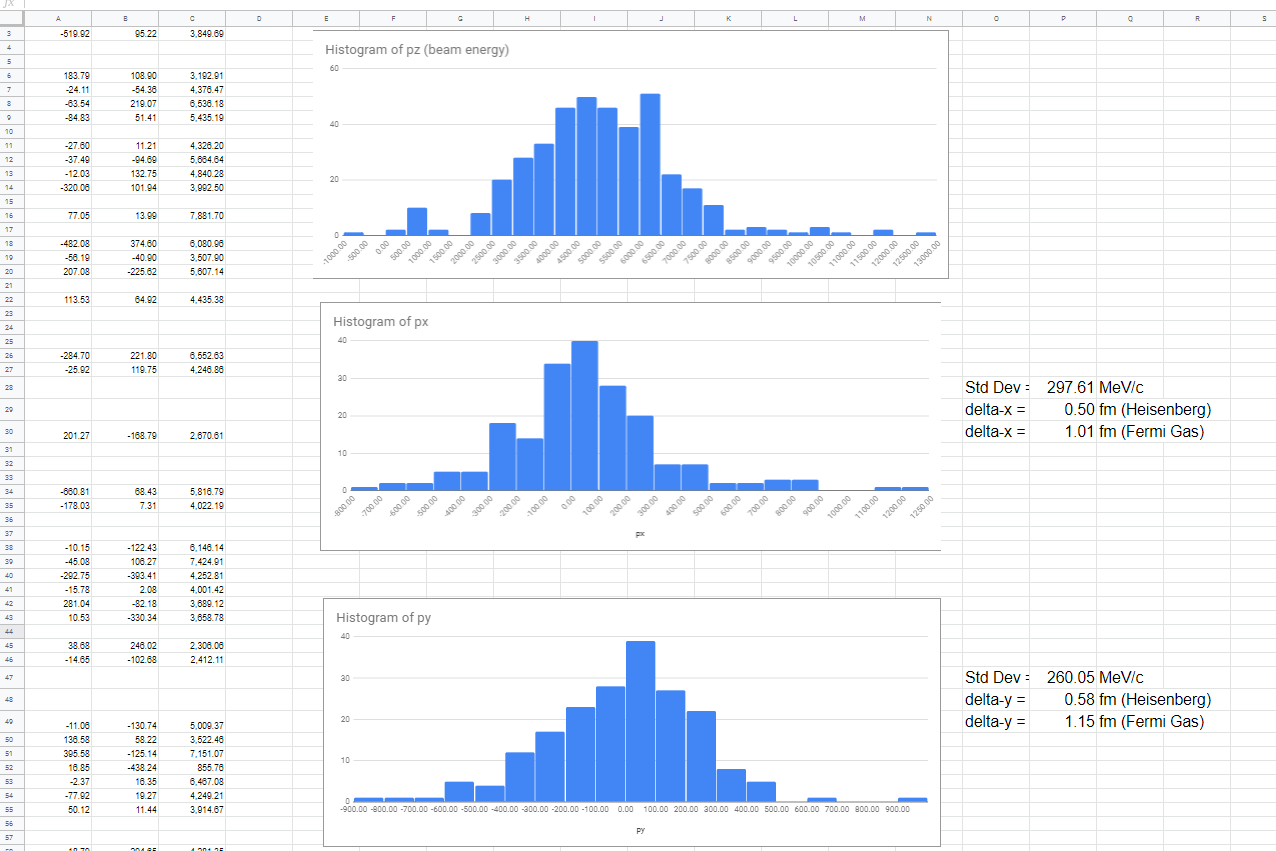
References and materials
- MINERvA (Fermilab) page
- International Masterclasses
- QuarkNet (for Neutrino Masterclass Library, go to MASTERCLASSES > NEUTRINO PROJECT MAP)
- Useful Wikipedia pages:
- All the data:
---------------------------------------------------------
Understanding MINERvA Masterclass Results
Navigation
- MINERvA Masterclass Documentation
- MINERvA Masterclass Guide
- Neutrino Masterclass Project Map
- MINERvA Masterclass website
This document is intended for masterclass leaders and physics teachers as a guide to explaining the results of the MINERvA masterclass to students.
Pedagogy
Enduring Understanding:
Indirect evidence provides data to study phenomena that cannot be directly observed.
Objectives:
- Apply conservation of momentum and energy to measure the approximate energy of a neutrino beam from the Fermilab accelerator complex.
- Apply conservation of momentum and energy to measure the properties of neutrons in nuclei of atoms in the target of a neutrino beam.
- Determine which events are signal events from which effective measurements may be made and which events are background that cannot be used for measurements.
Physics
Interaction:
A muon neutrino encounters a carbon nucleus in the targer area of MINERvA. It strikes a neutron in the nucleus and interacts by emittiing a W+ boson. The W+ is absorbed by a down quark in the neutron, changing it to an up quark and transforming the neutron into proton. When the neutrino emits the W+, it transforms into a muon. Both the muon and the proton carry the original momentum of the neutrino and thus move rapidly away from the carbon nucleus into the detector modules.
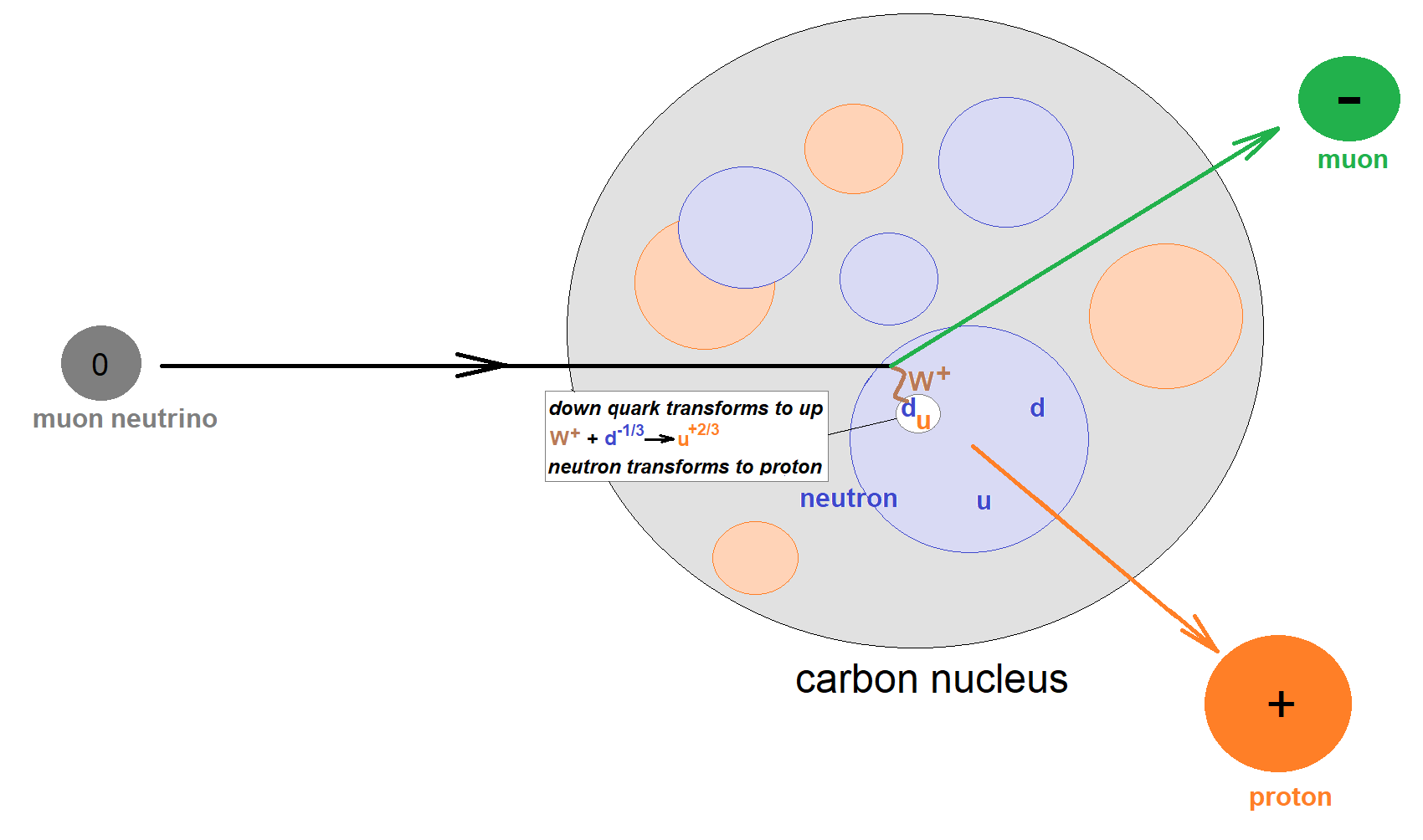
Beam momentum and energy:
The defined z-axis of the detector system is aligned to the direction of the Fermilab neutrino beam. The histogram of values of pz should make a normal distribution with the peak at the central value of the neutrino momentum in MeV/c. Since the masses of the neutrinos are extremely small and the momenta are quite high, the same number in MeV is the beam energy.
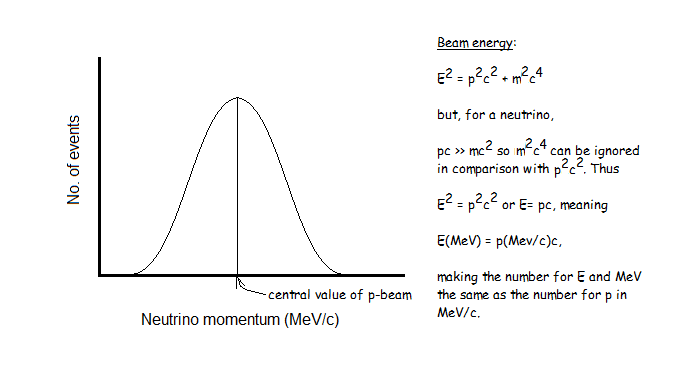
Momentum in x- and y-directions:
Since the momenta of the neutrinos are in the z-direction by definition, the net momenta they give to the outgoing protons and muons in the x- and y-directions must be zero. If the neutrons are initally rest before the interaction, then the histograms of net px and net py must peak at zero and be quite narrow. If there is a wide distribution, then the momenta in x and y must be random and mostly non-zero, producing a fairly wide normal distribution centerd on zero.
The uncertainty in the distribution of px or py can be estimated as half of the Full Width Half Maximum (FWHM/2). To find this, find the level halfway below the peak and measure the width of the distribution at that point. Divide by 2.
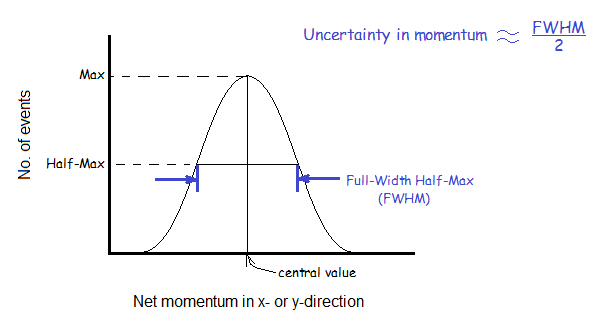
Radius of Carbon Nucleus:
The radius of an atomic nucleus in Fermi (fm; 1 fm = 10-15m) is extimated using the equation
R = (1.25 fm)A1/3,
where A is the atomic mass number. For carbon, A = 12 and therefore
R = (1.25 fm)(121/3) = 2.7 fm.
If the neutrons in carbon have their own momenta then they are constrained in their movement by the radius of the nucleus. If we understand the process of the neutron-neutrino interaction and resulting ejection of the proton and muon well enough, our x- and y-momentum data analysis should yield a reasonable estimate of this distance-of-travel constraint, that is, 2.7 fm, as the uncertainty in position of the neutron.
Calculation of Δx or Δy:
We shall examine Δx only as the analysis of Δy is identical.
The Heisenburg Uncertainty Principle states that the uncertainties in position and momentum form a complimentary pair, the products of which are no smaller than Planck's constant divided by 4π, or
ΔpxΔx ≥ h/4π.
Using momentum in MeV/c and distance in fm, it turns out that h/4π is about 150 MeV-fm/c. However, this assumes that the neutron is completely free to move. It is not as it is bound to quantized energy states in the nucleus and no two of them can occupy the same state due to the Pauli Exclusion Principle. A collection of particles that behaves this way is called a Fermi Gas; the Fermi Gas approximation of the behavior of the neutrons just about doubles the constant in the Uncertainty Principle to 300 MeV-fm/c. Then the uncertainty in x is estimated as
Δx = (300 MeV-fm/c) / Δpx.
If this number is significantly less that the carbon nuclear radius of about 2.7 fm, then there is more physics needed to fully understand the interaction. Getting the interaction right is one of the main purposes of MINERvA and is needed to make precision measurments of neutrinos in DUNE.
Addendum:
Rick Dower of the Boston QuarkNet Center prepared a thorough treatment showing mathematically how the distributions in momentum must be from quantum effects and not from thermal noise: Neutrino Target Motion.
--------------------------------------------------------------------------
MINERvA Masterclass Student Start Page 2023
Small URL for this page: http://tiny.cc/mmc-go.
Step 0: To start the MINERvA masterclass measurement, you need the following information:
- Name of your institute (usually the city)
- Date in the Fermilab time zone (U.S. Central Time)
- Data Group letter
- Data mergedTuple number
Here are some useful resources to help you:
Step 1: Find your Institute, Data Group, and Spreadsheet in this table:
Step 2: Open your Data Group by choosing the letter and find your mergedTuple by its number.
| Date/time CT | Institute (Data Group) | Institute (Data Group) | Institute (Data Group) | Spreadsheet |
|---|---|---|---|---|
| Sat 04 Mar/15:00 | FtCollins (A, B) | FNAL-04Mar2023 | ||
| Tue 07 Mar/15:00 | Lead (C) | FNAL-07Mar2023 | ||
| Fri 10 Mar/09:00 | Valencia (A B C D) | FNAL-10Mar2023 | ||
| Sat 25 Mar/08:00 | Constantine (B, D) | Kolkata (A) | FNAL-25Mar2023-1 | |
| Sat 25 Mar/14:00 | Duluth (A) | Mayaguez (C) | Piscataway (B,D) | FNAL-25Mar2023-2 |
*no videoconference
Step 3: Choose your mergedTuple to open the ARACHNE Simple event display. It will start with your first Gate (also called an Entry; ummm, think of each one as an "Entry Gate" to data in a specific time range). By the way, the first Entry Gate is marked Entry 0.
Notes:
- There is some "fake data" in the beginning of the first mergedTuple for each Data Group in the spreadsheet. It is simply a placeholder. You may (should) write over this when you put your own data in.
- Please enter data only in the space provided: under "Muon" and "Proton". All other space is needed for other purposes. Columns A and B are meant to guide you to the correct lines. Column O and beyond contain formulae and charts that depend on what you enter in Columns C-N.
- Never enter anything but data into the spreadsheet. It is an open sheet set up for numerical analysis. Addition of non-numerical data can ruin the calculations and plots. Putting the wrong or right things in the wrong places can do the same. Please be careful: you are entrusted with a spreadsheet that you share with many other students who depend on it.
Survey - do at the end!
Please take this student survey online after the videoconference. Each student should take this individually.
--------------------------------------------------------
Moderators' Page
Moderator Orientations
CERN: https://indico.cern.ch/event/1118890/
FNAL:
For orientation, moderators should watch the videos and read the documents that apply. Provision will be made for Q&A and discussion. Zoom connection information is in the Moderation Schedules below.
| Step 1: Videos | Step 2: Documents | Step 3: Q&A |
|---|---|---|
|
Options
|
FNAL
2023 Schedule for ATLAS masterclass videoconferences moderated by Fermilab
This will be updated as registrations are received.
Times(TBA) are in U.S. Central Time. (Convert to your time zone.) This schedule is subject to change.
| Date/time (U.S. Central Time) | Institutes | Moderator(s) | Staff | Zoom link |
|---|---|---|---|---|
| Sat 25 Feb/10:00 | LisboaUni | Conde, Van de Wall | Cecire, Wood | FNAL-IMC-A |
| Fri 03 Mar/15:00 | Stillwater A, Ruston | Assamagan, Bhopatkar | Trapp, Cecire | FNAL-IMC-A |
| Sat 04 Mar/15:00 | Santa Cruz | Assamagan | Wetzler | FNAL-IMC-A |
| Thu 09 Mar/15:00 | Dallas | Foti, Uribe | Cecire, Wadness | FNAL-IMC-B |
| Tue 14 Mar/13:45 | DeKalb | Cecire | Cecire | FNAL-IMC-A |
| Sat 25 Mar/10:00 | Coimbra, Evora, LisboaLIP | Peixoto, Van de Wall | Wetzler | FNAL-IMC-A |
| Sat 25 Mar/15:00 | Stillwater C w/Houston | Glover. Natale | Wetzler, Trapp | FNAL-IMC-B |
| Fri 31 Mar/15:00 | Stillwater D | Hall | Cecire | FNAL-IMC-A |
2023 Schedule for CMS masterclass videoconferences moderated by Fermilab
This will be updated as registrations are received.
Times(TBA) are in U.S. Central Time. (Convert to your time zone.) This schedule is subject to change.
| Date/time (U.S. Central Time) | Institutes | Moderator(s) | Staff | Zoom link |
|---|---|---|---|---|
| Sat 25 Feb/15:00 | Buffalo, Uramita | Albrow, Norberg | Cecire, Wood | FNAL-IMC-C |
| Tue 28 Feb/15:30 | NotreDame, Puebla A | Rahmat, Martinez | Wood | FNAL-IMC-C |
| Thu 02 Mar/09:00 | Constantine | Hall | Cecire | FNAL-IMC-C |
| Sun 05 Mar/14:00 | Baltimore | Mantilla | Wegner | FNAL-IMC-C |
| Thu 09 Mar/20:00 | Singapore | Yu | Cecire | FNAL-IMC-C |
| Fri 10 Mar/17:00 | Honolulu, MexicoCity-Ibero | Uribe, Natale | Wegner | FNAL-IMC-C |
| Sat 11 Mar 15:00 | Boston, Hermosillo, Medellin, Williamsburg | Malik, Vazquez | Wegner | FNAL-IMC-B |
| Sat 11 Mar/15:00 | Orange, Seattle | Adelman | Cecire | FNAL-IMC-C |
| Thu 16 Mar//02:45 | Shanghai | Natale, Barney | Cecire, Klammer | FNAL-IMC-C |
| Sat 18 Mar/15:00 | Hammond, West Lafayette | Natale, Norberg | Cecire? | FNAL-IMC-C |
| Fri 24 Mar/21:00 | Auckland | Wood | Glover | FNAL-IMC-C |
| Sat 25 Mar/15:00 | Houston w/Stillwater C-ATLAS | Natale, Glover | Trapp, Wetzler | FNAL-IMC-B |
| Sat 25 Mar/16:00 | Montelibano, Cuenca, Quito-EPN, Quito-USFQ | Glover, Capdevilla | Trapp | FNAL-IMC-C |
| Thu 30 Mar/15:00 | MexicoCity-PrepaIbero, Osorio | Uribe, Ventura | Cecire | FNAL-IMC-C |
| Fri 31 Mar/14:00 | ManhattanKS, PueblaC | Hall, Gerber | Cecire | FNAL-IMC-C |
2023 Schedule for MINERvA masterclass videoconferences moderated by Fermilab
This will be updated as registrations are received.
Times (TBA) are in U.S. Central Time. (Convert to your time zone.) This schedule is subject to change.
| Date/time (U.S. Central Time) | Institutes | Moderator(s) | Staff | Zoom link |
|---|---|---|---|---|
| Sat 04 Mar/15:00 | FtCollins | Junk | Wood* | FNAL-NuMC |
| Tue 07 Mar/15:00 | Lead | Norrick | Plucinski, Randall | FNAL-NuMC |
| Fri 10 Mar/09:00 | Valencia | Olivier | Pasero | FNAL-NuMC |
| Wed 15 Mar/12:00 | Canadaigua | Oliver | Pasero | FNAL-NuMC |
| Sat 25 Mar/08:00 | Constantine, Kolkata | Fields, Junk | Wood | FNAL-NuMC |
| Sat 25 Mar/14:00 | Duluth, Mayaguez | Fields, Junk | Wood | FNAL-NuMC |
NOvA masterclass videoconference moderated by Fermilab
| Date/time (U.S. Central Time) | Institutes | Moderator(s) | Staff | Zoom link |
|---|---|---|---|---|
| Sat 11 Mar | Minneapolis | FNAL-NuMC | ||
| Sat 25 Mar | Irvine | FNAL-NuMC |
2023 "Off-Shell" Schedule for ATLAS, CMS, MINERvA, and other masterclass videoconferences moderated by Fermilab or TRIUMF
This will be updated as registrations are received.
Times (TBA) are in U.S. Central Time. (Convert to your time zone.) This schedule is subject to change.
| Date/time (U.S. Central Time) | Institutes | Measurement | Moderator(s) | Moderation Center | Staff | Zoom link |
|---|---|---|---|---|---|---|
| Sat 22 Apr/15:00 | Berkeley | ATLAS | Bhopatkar | |||
| Sat 13 May | Lead | NOvA |
Videconference Plan
Times will vary. Revised Feb 2022. There is no provision for reports from Institutes*.
| Time from start | Item | Remarks |
|---|---|---|
| -00:10 | Moderators arrive; institutes log in | test and establish video and audio connections |
| +00:00 | Start |
|
| +00:05 | Combined results | |
| +00:15 | Q&A | moderators take questions from students |
| +00:25 | Quiz | time allowing (10 question version) (5 question version) |
| +00:35 | Videoconference ends | time varies |
*Some will present results anyway. That is OK.
Suggestions on how to be an effective Masterclass moderator:
You might know most of this already...but we still need to remind ourselves. Please send in items to add to this list.
- Speak clearly and succinctly
- Show your sense of humor
- Avoid too many explanations: draw ideas from students and then help them
- When you do explain, keep it short and direct
- Encourage students to speak up, give their views, and back them up
- Mind the schedule
- Be friendly
- It is alright to disagree...with mentors, students, or each other
- Let students get a feel for how you see data and analysis
- Be familiar with the Masterclass measurement
- Show your enthusiasm
- Work as a team
Suggested background images for your videocon:
- Wilson Hall with IERC (artistic)
- Wilson Hall, FNAL 50th
- Broken Symmetry and sign
- Atrium
- ROC
- International Masterclasses logo
-----------------------------------------------------------------------
NuOrientation 2023
Navigation
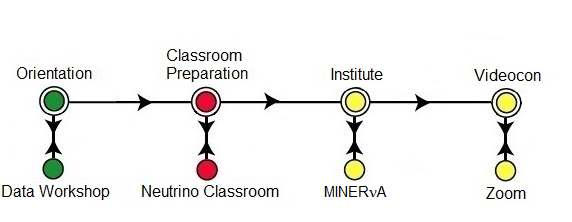
Masterclass Orientation
If your instituion is new to masterclasses or to the flavor of masterclass you intend pursue, a full orientation is in order. A masterclass orienation can be done online via Zoom or in person with a visit from a QuarkNet staff member or fellow. It is intended for teachers and mentors. Here is what is covered:
- Classroom prep for the masterclass
- Try out a MINERvA neutrino masterclass measurement
- Walk-through of masterclass logistics
- Masterclass Library
- Zoom test
- Q&A
This generally takes 1-3 hours, though it can be trimmed or extended depending on need. If you have had a MINERvA Data Workshop in the past year, it counts as an orientation. If you had one previous to this, you may still need an orientation update, which generally takes one hour..
Institutions in MicroBooNE masterclasses need a full orientation as this is a new measurement.
Register for Masterclass Orientation on the Google form at least one week prior to your earliest preferred date!
Experienced Institutes: Orientation Updates
An orientation update is to bring teachers and mentors up to speed on the latest in masterclass measurements and procedures. As orientation updates are done online, they also serve as Zoom tests. Orientation updates take 1-2 hours.
Register for Masterclass Orientation on the Google form at least one week prior to your earliest preferred date!
Orientation Schedule 2023
Start time in CT and facilitator in parentheses. Nota bene: we can accommodate days and times not yet shown on this schedule. Zoom channel links will be provided directly to participants.
| Date 2023 | MINERvA Orientation | MINERvA Update | Notes/Remarks |
|---|---|---|---|
| Tue 22 Feb | Practice Sheet | ||
| Sat 04 Mar | Mayaguez (08:00-15:00 w/12:00 Zoom) | ||
| Thu 23 Feb | Fort Collins, Lead (16:00-17:00) | ||
| Sat 05 Mar | Practice Sheet |
* Site visit.


